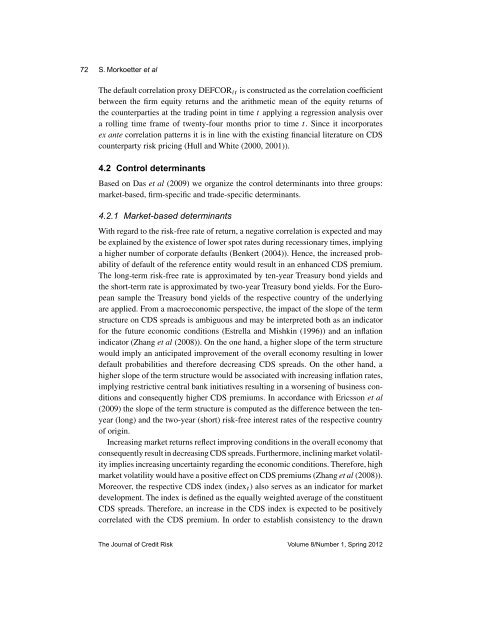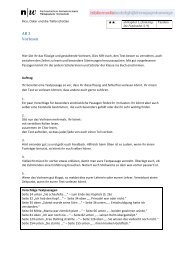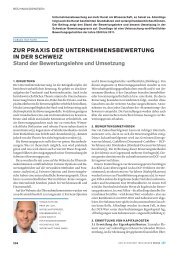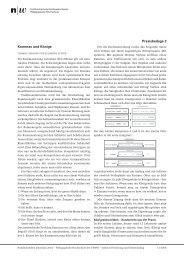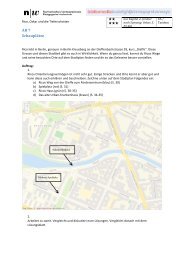The impact of counterparty risk on credit default swap pricing dynamics
The impact of counterparty risk on credit default swap pricing dynamics
The impact of counterparty risk on credit default swap pricing dynamics
Create successful ePaper yourself
Turn your PDF publications into a flip-book with our unique Google optimized e-Paper software.
72 S. Morkoetter et al<str<strong>on</strong>g>The</str<strong>on</strong>g> <strong>default</strong> correlati<strong>on</strong> proxy DEFCOR it is c<strong>on</strong>structed as the correlati<strong>on</strong> coefficientbetween the firm equity returns and the arithmetic mean <str<strong>on</strong>g>of</str<strong>on</strong>g> the equity returns <str<strong>on</strong>g>of</str<strong>on</strong>g>the counterparties at the trading point in time t applying a regressi<strong>on</strong> analysis overa rolling time frame <str<strong>on</strong>g>of</str<strong>on</strong>g> twenty-four m<strong>on</strong>ths prior to time t. Since it incorporatesex ante correlati<strong>on</strong> patterns it is in line with the existing financial literature <strong>on</strong> CDS<str<strong>on</strong>g>counterparty</str<strong>on</strong>g> <str<strong>on</strong>g>risk</str<strong>on</strong>g> <strong>pricing</strong> (Hull and White (2000, 2001)).4.2 C<strong>on</strong>trol determinantsBased <strong>on</strong> Das et al (2009) we organize the c<strong>on</strong>trol determinants into three groups:market-based, firm-specific and trade-specific determinants.4.2.1 Market-based determinantsWith regard to the <str<strong>on</strong>g>risk</str<strong>on</strong>g>-free rate <str<strong>on</strong>g>of</str<strong>on</strong>g> return, a negative correlati<strong>on</strong> is expected and maybe explained by the existence <str<strong>on</strong>g>of</str<strong>on</strong>g> lower spot rates during recessi<strong>on</strong>ary times, implyinga higher number <str<strong>on</strong>g>of</str<strong>on</strong>g> corporate <strong>default</strong>s (Benkert (2004)). Hence, the increased probability<str<strong>on</strong>g>of</str<strong>on</strong>g> <strong>default</strong> <str<strong>on</strong>g>of</str<strong>on</strong>g> the reference entity would result in an enhanced CDS premium.<str<strong>on</strong>g>The</str<strong>on</strong>g> l<strong>on</strong>g-term <str<strong>on</strong>g>risk</str<strong>on</strong>g>-free rate is approximated by ten-year Treasury b<strong>on</strong>d yields andthe short-term rate is approximated by two-year Treasury b<strong>on</strong>d yields. For the Europeansample the Treasury b<strong>on</strong>d yields <str<strong>on</strong>g>of</str<strong>on</strong>g> the respective country <str<strong>on</strong>g>of</str<strong>on</strong>g> the underlyingare applied. From a macroec<strong>on</strong>omic perspective, the <str<strong>on</strong>g>impact</str<strong>on</strong>g> <str<strong>on</strong>g>of</str<strong>on</strong>g> the slope <str<strong>on</strong>g>of</str<strong>on</strong>g> the termstructure <strong>on</strong> CDS spreads is ambiguous and may be interpreted both as an indicatorfor the future ec<strong>on</strong>omic c<strong>on</strong>diti<strong>on</strong>s (Estrella and Mishkin (1996)) and an inflati<strong>on</strong>indicator (Zhang et al (2008)). On the <strong>on</strong>e hand, a higher slope <str<strong>on</strong>g>of</str<strong>on</strong>g> the term structurewould imply an anticipated improvement <str<strong>on</strong>g>of</str<strong>on</strong>g> the overall ec<strong>on</strong>omy resulting in lower<strong>default</strong> probabilities and therefore decreasing CDS spreads. On the other hand, ahigher slope <str<strong>on</strong>g>of</str<strong>on</strong>g> the term structure would be associated with increasing inflati<strong>on</strong> rates,implying restrictive central bank initiatives resulting in a worsening <str<strong>on</strong>g>of</str<strong>on</strong>g> business c<strong>on</strong>diti<strong>on</strong>sand c<strong>on</strong>sequently higher CDS premiums. In accordance with Ericss<strong>on</strong> et al(2009) the slope <str<strong>on</strong>g>of</str<strong>on</strong>g> the term structure is computed as the difference between the tenyear(l<strong>on</strong>g) and the two-year (short) <str<strong>on</strong>g>risk</str<strong>on</strong>g>-free interest rates <str<strong>on</strong>g>of</str<strong>on</strong>g> the respective country<str<strong>on</strong>g>of</str<strong>on</strong>g> origin.Increasing market returns reflect improving c<strong>on</strong>diti<strong>on</strong>s in the overall ec<strong>on</strong>omy thatc<strong>on</strong>sequently result in decreasing CDS spreads. Furthermore, inclining market volatilityimplies increasing uncertainty regarding the ec<strong>on</strong>omic c<strong>on</strong>diti<strong>on</strong>s. <str<strong>on</strong>g>The</str<strong>on</strong>g>refore, highmarket volatility would have a positive effect <strong>on</strong> CDS premiums (Zhang et al (2008)).Moreover, the respective CDS index (index t ) also serves as an indicator for marketdevelopment. <str<strong>on</strong>g>The</str<strong>on</strong>g> index is defined as the equally weighted average <str<strong>on</strong>g>of</str<strong>on</strong>g> the c<strong>on</strong>stituentCDS spreads. <str<strong>on</strong>g>The</str<strong>on</strong>g>refore, an increase in the CDS index is expected to be positivelycorrelated with the CDS premium. In order to establish c<strong>on</strong>sistency to the drawn<str<strong>on</strong>g>The</str<strong>on</strong>g> Journal <str<strong>on</strong>g>of</str<strong>on</strong>g> Credit Risk Volume 8/Number 1, Spring 2012


